Friendly Tip: The version used for the following Q&A is PVsyst 6.68 or above. For other versions, please refer to this for guidance.
1. In the PVsyst 6.70 version, why is the near-field shading loss not 0% after selecting inverse tracking for a flat single-axis bifacial system?
[Teacher Jiang from Candela Academy]answer: Solar radiation primarily consists of direct radiation, scattered radiation, and reflected radiation from the terrain. Direct radiation is a portion of solar radiation that strikes a surface as parallel rays. When PV modules are shaded, distinct shadows are cast behind them.
The 'Near Shading loss' in near-field shadow loss primarily encompasses the obstruction loss of direct radiation, scattered radiation, and reflected radiation, which is present in both fixed and tracking systems. However, using backtracking reduces the obstruction loss of direct radiation to zero, revealing the loss of scattered radiation, which is always mixed and cannot be separated in fixed systems.
For the flat single-axis tracking system, backtracking is used, resulting in a 0% loss of direct radiation. However, for scattered radiation, regardless of whether it is backtracked or not, as long as there are multiple rows, the actual received scattered radiation by the PV modules will be less compared to a single row.
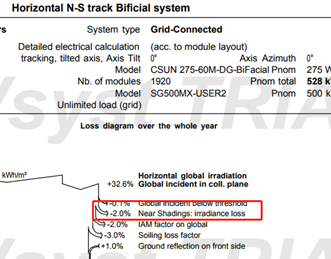
▲Figure 1
2. How can we quickly obtain the area occupied by the entire 3D array?
[Teacher Chen from Candela Academy]answer: According to array layout and GCR, rapid calculation can be performed. As shown in Figure 2, the area of the module array is 130 square meters, and the GCR is 54.8% (3.34/6.1*100%). Therefore, the occupied area is: 130/54.8%=237.226 square meters.
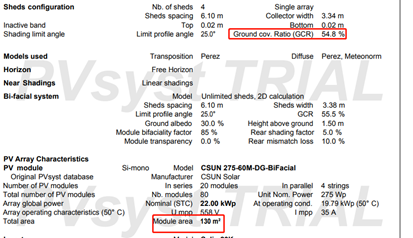
▲Figure 2
3. There is an issue with importing ASCII meteorological data in PVsyst version 6.67. How can it be resolved?
[Teacher Chen]answer: The actual ASCII data can be imported into PVsyst versions 6.60 to 6.68 without any issues during the import process. However, issues may arise with the imported data, as shown in Figures 3 and 4. The issue has been fixed in the current PVsyst version 6.70.
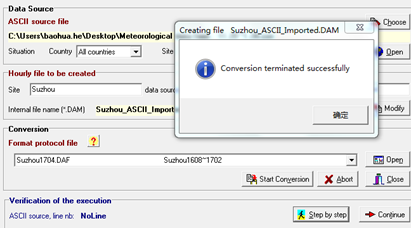
▲Figure 3: Imported successfully interface
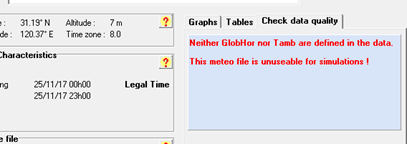
▲Figure 4 Data display abnormal interface
4. Regarding the parameter settings for unlimited sheds in PVsyst version 6.68, why are the results reported in the Report inconsistent?
[Teacher Chen] answer: For the PVsyst 6.68 version, the Unlimited sheds parameter settings, such as inactive band and shading, are set to 0.02m respectively. However, we found that they are not displayed normally or are displayed incorrectly on the report page, including the limit angle. The correct values for GCR should be 34.3° and 74%. Currently, the PVsyst 6.70 version has corrected this issue.
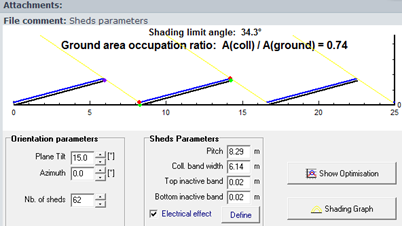
▲ Figure 5

▲Figure 6
5. When importing DAE format 3D models from Google SketchUp software into PVsyst, the following issues arise. How can they be resolved?
[Teacher Chen] answer: You need to double-click to open the building model in 3D modeling, switch from wireframe mode to solid mode , and click the "Invert normals" button
, and click the "Invert normals" button on the top right to reverse the "back-facing faces" to "front-facing".
on the top right to reverse the "back-facing faces" to "front-facing".
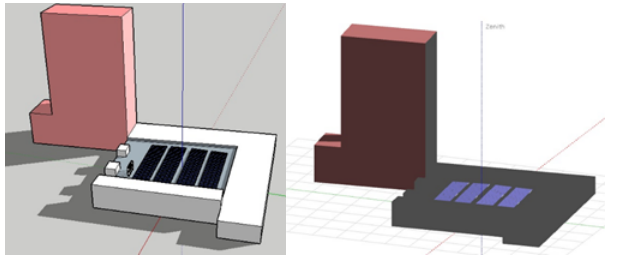
▲ Figure 7
6. Does PVsyst currently consider the radiation on the back side when calculating the PR for bifacial systems?
[Teacher Chen] answer: This is a PR definition issue. Currently, the PR calculation for Bifacial system in PVsyst software does not take into account the theoretical power generation of the back side. There is no official standard for this yet, and the difficulty lies in the fact that accurately assessing the radiation on the back side is very challenging.
7. In the design phase of strings, if the open-circuit voltage and operating voltage values of the strings calculated based on the temperature coefficient are inconsistent with the calculated values from PVsyst, what are the implications?
[Teacher Chen] answer: Assuming the STC open-circuit voltage (Voc) value on the PV module datasheet is 38.2V, the operating voltage (Vmpp) value is 30.9V, and the temperature coefficient of open-circuit voltage (Temper. coeff. of Voc) is -0.34%/℃.
The default open-circuit voltage temperature coefficient of PVsyst is a calculated value based on the single diode model, as shown in Figure 8. The open-circuit voltage temperature coefficient of a certain PV module is -0.33%/℃, and the temperature coefficient of its operating voltage is -0.43%/℃. A certain string consists of 10 PV modules connected in series.
According to the linear calculation formula:
● Open-circuit voltage at -10 degrees Celsius: Voc(-10) = Voc,stc * (1 + (Toc-Tstc)*b) = 38.2 * (1 + (-10 - 25) * (-0.33%)) = 42.6221V;
● The Voc of strings (-10C) = 10 * 42.6221V = 426.221V; there is a difference of about 1V from the calculated value of the PVsyst Model.
● Vm(60) = 30.9 * (1 + (60 - 25) * (-0.43%)) = 26.2495V; Vm(60C) = 262.495V; the difference with the calculated value of the PVsyst model is about 2V.
[Reason for the difference]: When temperature changes, the variation in voltage is not entirely linear, and it has a relatively minor impact on the system's compatibility design.

▲ Figure 8
8. What is the relationship between the optimal irradiation angle and the optimal tilt of the System?
[Teacher Chen] answer: The optimal irradiation angle is the installation tilt angle that corresponds to the peak irradiation value as the installation tilt angle of the PV modules is continuously increased from 0. The optimal tilt angle of the system takes into account factors such as GCR, installation spacing, installation cost, and production, with the goal of achieving the lowest LCOE over the entire life cycle.
9. How to export the Pan file of a specific component in the Database system?
[Teacher Chen] answer: Firstly, you need to save the PAN file from the database to your local computer (after modifying any parameters based on the original data, you can save it as another pan.file, which can then be saved locally. Reopen the PAN and revert the modified parameters. Secondly, use "File-export components-PV modules-..." to export the PAN file.
Tip: Interested readers can refer to past articles to search for issues encountered while using PVsyst.
Article Comments(0)